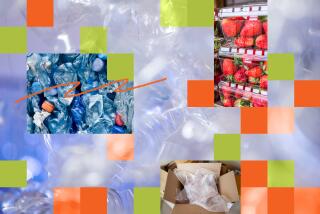Amazon’s streamlined plastic packaging is jamming up recycling centers

Over the last year, Amazon.com Inc. has reduced the portion of shipments it packs in its cardboard boxes in favor of lightweight plastic mailers, which enable the retailing giant to squeeze more packages into delivery trucks and planes.
But environmental activists and waste experts say the new plastic sacks, which aren’t recyclable in curbside recycling bins, are having a negative effect.
“That Amazon packaging suffers from the same problems as plastic bags, which are not sortable in our recycling system and get caught in the machinery,” said Lisa Sepanski, project manager for the King County Solid Waste Division, which oversees recycling in King County, Wash., where Amazon is based. “It takes labor to cut them out. They have to stop the machinery.”
Last year’s holiday season, the busiest for e-commerce, meant ever more shipments — creating a massive hangover of packaging waste. As the platform behind half of all e-commerce transactions in 2018, according to EMarketer, Amazon is by far the biggest shipper and producer of that waste — and it’s a trendsetter, meaning that its switch to plastic mailers could herald a shift across the industry. Other retailers that use similar plastic mailers include Target Corp., which declined to comment.
The problem with the plastic mailers is that they need to be recycled separately, and if they end up in the usual stream, they gum up recycling systems and prevent larger bundles of materials from being recycled. Environmental advocates say Amazon, as the industry giant, needs to do a much better job of encouraging consumers to recycle the plastic mailers by providing more education and places to bring that plastic for recycling.
“We are continually working to improve our packaging and recycling options, and have reduced packaging waste by more than 20% globally in 2018,” Amazon spokeswoman Melanie Janin said. She added that Amazon provides recycling information on its website. (Amazon Chief Executive Jeff Bezos owns the Washington Post.)
Amazon’s goal to reduce bulkier cardboard is the right move, said a number of waste experts. And plastic mailers have some positives for the environment. They take up less space in containers and trucks than boxes, making shipping more efficient. Fewer greenhouse gases are emitted — and less petroleum consumed — by the production, use and disposal of plastic film compared with recycled cardboard, said David Allaway, senior policy analyst for the Oregon Department of Environmental Quality’s Materials Management Program.
Plastic is so cheap and enduring that many companies use it for packaging.
But people are prone to put plastic sacks into recycling bins.
Plastic mailers escape the notice of sorting machines and get into bales of paper bound for recycling, contaminating entire bundles, which experts say outweighs the positive effect of reducing bulky cardboard shipments. Paper bundles used to fetch a high price on international markets and had long sustained profits in the recycling industry. But mixed bales are so hard to sell — because of stricter laws in China, where many are sent for recycling — that many West Coast recycling companies must trash them instead. (Packaging is just one source of plastics contamination of paper bales bound for recycling.)
“As packaging gets more complex and lighter, we have to process more material at slower speeds to produce the same output. Are the margins enough? The answer today is no,” said Pete Keller, vice president of recycling for Republic Services, one of the largest U.S. waste haulers. “It’s labor- and maintenance-intensive and, frankly, expensive to deal with on a daily basis.”
For the last 10 years, Amazon has whittled away at unnecessary packaging, shipping products in their original box when possible or in the lightest possible packaging. Spokeswoman Janin said Amazon shifted to lightweight plastic mailers in the last year as part of a larger effort to reduce packaging waste and operational costs. Amazon, she wrote, “is currently scaling capacity of a fully recyclable cushioned mailer that is recyclable in paper recycling streams.”
One of the few Fortune 500 companies not to file a corporate social responsibility or sustainability report, Amazon said its “Frustration-Free” packaging program reduced packaging waste by 16% and eliminated the need for more than 305 million shipping boxes in 2017.
“Their move to flexible packaging, in my belief, is driven by cost and performance, but there’s also a low carbon footprint,” said Nina Goodrich, director of the Sustainable Packaging Coalition. She oversees a How2Recycle logo that began appearing on Amazon’s padded plastic mailers in December 2017, a step toward consumer education.
Another problem with the new padded plastic mailers is that Amazon and other retailers affix a paper address label that renders them unfit to be recycled, even at a store drop-off location. The label needs to be removed, separating the paper from the plastic, in order for the material to be recyclable.
“Companies can take a good material, and depending on label, adhesive or ink, make it non-recyclable,” Goodrich said.
For now, those padded plastic Amazon mailers can be recycled once consumers remove the label and bring the mailer to drop-off sites found outside some chain stores. Clean, dry and in aggregate, such plastic can be melted and made into composite lumber for decks. Cities with plastic-bag bans, like Amazon’s hometown of Seattle, contain fewer drop-off sites.
Only 4% of plastic film accrued by U.S. households is recycled through collection programs at grocery and big-box stores, according to a 2017 Closed Loop report about U.S. recycling. The other 96% becomes garbage, even if put into curbside recycling, and ends up in landfills.
Some countries put the onus on companies to take greater financial and management responsibility for their products after consumers have finished using them. In these systems, companies pay fees based on how much waste their products and packaging contribute.
To comply with its legal obligations, Amazon pays these fees in some countries outside the United States. It is already subject to such systems in Canada, according to the nonprofit Canadian Stewardship Services Alliance, which supports the programs throughout the provinces.
Amid the immense patchwork of U.S. recycling laws, such requirements have not yet gained federal favor except when dealing with specific toxic and valuable materials such as electronics and batteries.
The physical lockers Amazon maintains for consumers to return products could accept used packaging, experts suggested, adding that Amazon could commit to recycling that plastic for future use in its shipping mailers.
“They could do a reverse distribution, taking materials back to their distributions system. Those collection points become very important to make it convenient for consumers,” said Scott Cassel, chief executive of the Product Stewardship Institute, a membership-based nonprofit focused on reducing the environmental impact of consumer products. “But it would cost them money.”
More to Read
Inside the business of entertainment
The Wide Shot brings you news, analysis and insights on everything from streaming wars to production — and what it all means for the future.
You may occasionally receive promotional content from the Los Angeles Times.










